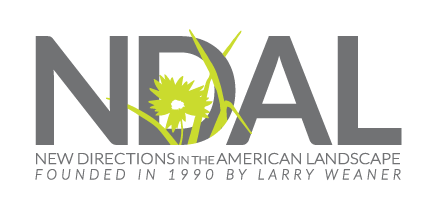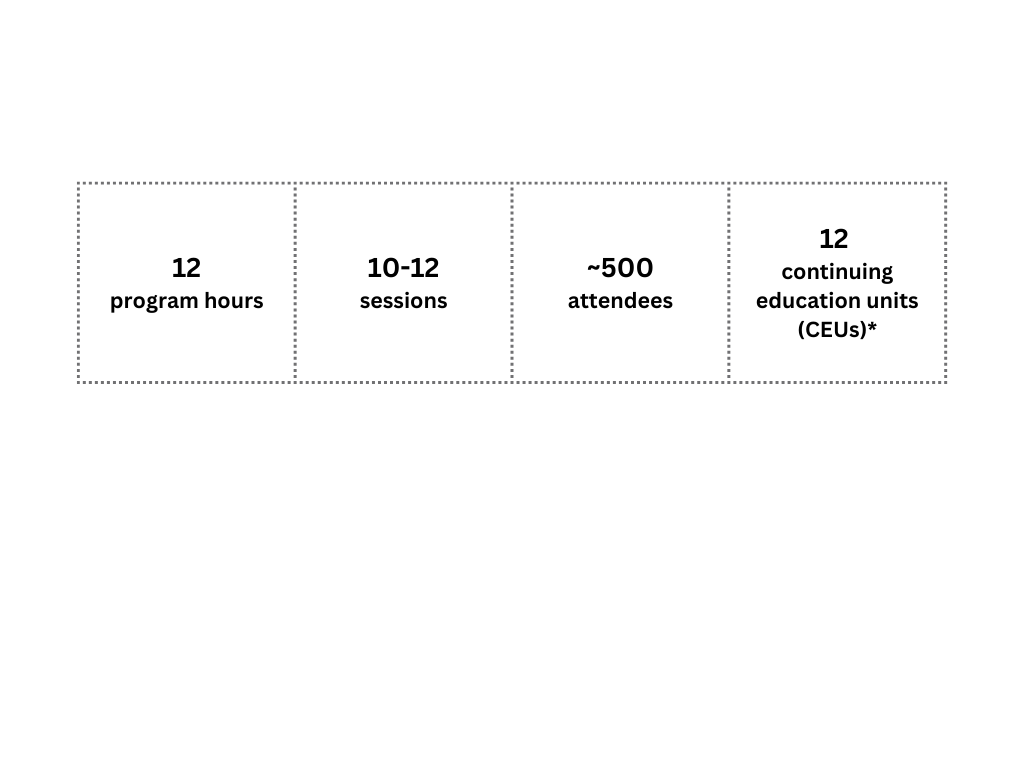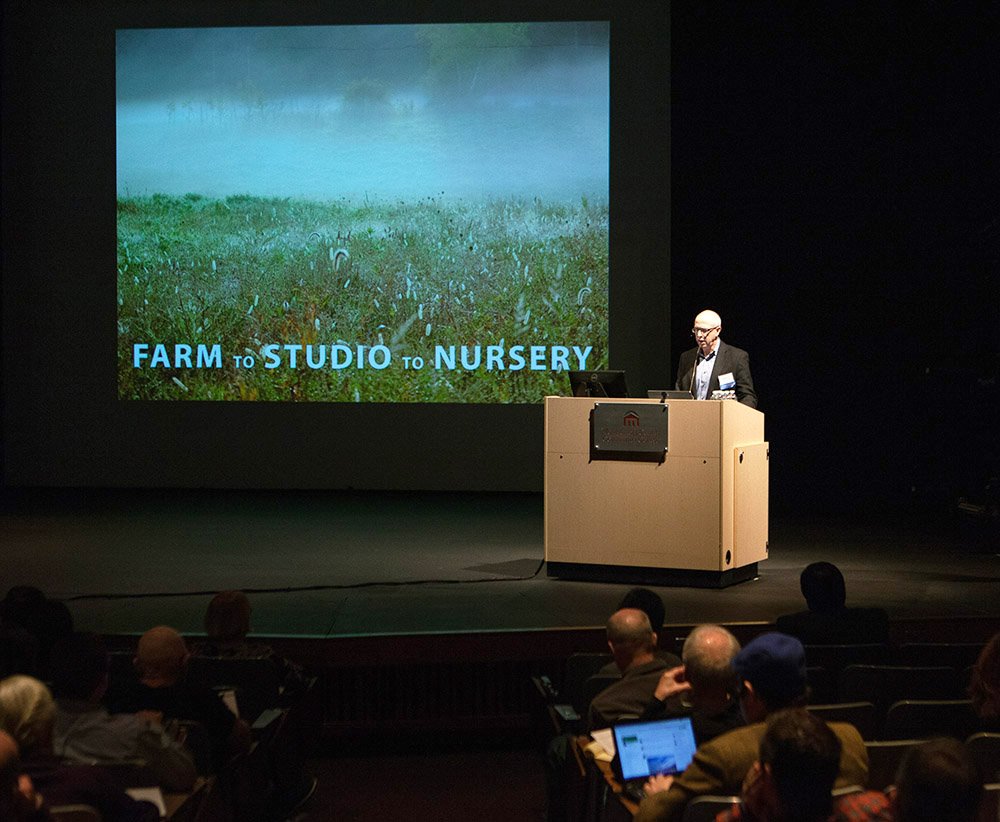
Annual Design Symposia:
Landscape, Ecology & Culture
New Directions in the American Landscape has been a pioneering influence in bringing ecology to the fore of landscape design.
Since 1990, our annual two-day symposium, in partnership with the Morris Arboretum of the University of Pennsylvania and the Connecticut College Arboretum, has been a fixture in the landscape design and management fields. As of 2023, the symposium will go by the name Landscape, Ecology, & Culture.
NDAL has changed and is changing how things are done in the landscape profession. With unique vision and dedication, NDAL continues to inspire diverse practitioners. As one landscape architect said who regularly attends the annual conference, “I go home inspired.”
A full line-up of NDAL’s past Annual Symposia can be viewed and downloaded below (you’ll need Adobe Reader).
This Program at a Glance:
Program type: In-person & live virtual (hybrid) plus recordings available for 3 months
Upcoming program dates: January 10-11, 2024 (PA), January 17-18, 2024 (CT & live virtual)
Audience type: Landscape professionals
*Amount of CEUs varies based on the continuing education organization
Past Annual Design Symposia by Year:
-
Founded in 1990, our annual two-day symposium has a long tradition of celebrating native plants and exploring landscape design at the intersections of ecology, culture, and art. The symposium series deliberately pushes the envelope, offering in-depth explorations of overlooked and forward-looking topics not presented elsewhere and providing practical, concrete information in lieu of trendy jargon. Our programs reflect the diverse factors that shape landscapes and regularly feature designers, ecologists, horticulturists, historians, artists, and anthropologists, among other disciplines. We look forward to seeing you at the symposium!
-
Landscape designers who successfully employ an ecology-based approach typically draw from a variety of sources. The inextricable link between people and ecology only increases the need to broaden their investigative lens. Join us as we explore the integration of ecology-based design with people-based factors, including the lingering effects of historic land use and the need to accommodate diverse cultural perspectives on the meaning of “ecology.”
-
Incorporating science into landscape design is of little use if the resulting plantings are not harmonious to the people who engage with them, and are not in tune with the animals that depend on them. In this virtual symposium we will explore how scientific research can lead to tangible approaches for a new landscape tradition, one where ecological, anthropological, and sociological considerations expand the scope of landscape design.
-
Culture and ecology exist in a dynamic relationship: culture shapes ecology and vice versa. Our 2020 conference will explore this feedback loop as it pertains to landscape design and management. From historical as well as contemporary perspectives, our presenters will consider the complex, sometimes overlooked ways in which culture and ecology interact and what this means for how ecology-based design can be most effective.
-
When NDAL’s first symposium took place in 1990, native plants were largely an afterthought in the landscape professions. The changes since then have been astounding, and NDAL is proud to have played a part. While “ecology into design” has and will remain NDAL’s focus, we have increasingly understood that a “real world ecology” must always consider the influences of people past and present. Our 30th anniversary program will illustrate how an expanded definition of “ecological design”— including contributions from garden history, agroecology, anthropology, social justice, art, and of course the ecological sciences—can yield environmentally sound, yet culturally connected landscapes.
-
Our 29th Annual Symposium explores a core challenge of contemporary landscape design: blending plants, wildlife, and people in spaces that advance ecological function and are enjoyable to be in. While the destination is clear, the route is complex and often ill-defined or nonexistent. Learn from real world experiences of a select group of landscape architects and designers who are successfully navigating this challenge.
-
Natural landscapes are inherently complex, shaped by intricate ecological processes and past human activity. A designer’s ability to succeed amidst this complexity can be greatly enhanced through careful examination of relevant ecological research and analysis. Join us at our two-day conference as highly accomplished ecologists and designers explore the synthesis of sophisticated analysis and creative design.
-
Typically landscape designers first determine their overall design direction, and then zoom in to design the details. But in an ecology-based approach, a site’s intricate environmental characteristics can and should influence big picture decisions. This two-day conference will explore crucial aspects of the native design process, beginning at the scale of individual species, and gradually zooming out to include plant community design, ecological master planning, and methods for creating sophisticated ecological designs within the context of current as well as emerging landscape practices.
-
To work with the land today means dealing with dramatic change. Factors from landscape fragmentation to accidental species introductions have made it difficult to establish resilient plant communities. Yet increased interest in ecology, landscape performance, and natural aesthetics has created a significant need to establish these landscapes successfully and consistently. This two-day conference will explore how to interact with the complex, evolving realities of today’s landscapes and those of the future. Join us for our 26th year!
-
Practices that were new and innovative in 1990, when this conference series began, may be commonplace today…or even wrong. In this two-day program, influential practitioners, both established and emerging, will examine some of the dead ends and fruitful paths traveled by ecological design over the last 25 years, and the changes that these experiences suggest going forward.
-
To design and manage landscapes successfully is to create symbiotic relationships between people and living systems. While these systems are highly complex, research into their interactions, patterns, and processes is robust. This conference will explore the connections between science and design and the potential for these connections to profoundly alter how we create and manage small and large scale landscapes.
-
The expanding scope, scale, and goals of today’s landscape projects often require practitioners to consult with, and incorporate knowledge from, a variety of other disciplines. Learn how an interdisciplinary approach to designing ecology based landscapes can help you adapt to the rapid changes our profession is experiencing and enhance your position in a competitive economic environment.
NDAL deliberately pushes the envelope, offering in-depth explorations of overlooked and forward-looking topics not available elsewhere. Designers are often asked to present on emerging or unknown aspects of their work. Speakers and attendees alike commend this format: it enables presenters to refine developing ideas with an informed audience, and students and new professionals benefit from demonstration of process.
-
Relying on traditional landscape methods in a new era of ecological design simply won’t cut it. In this two-day program we will look to a variety of disciplines, cultures, and art forms for concrete strategies that respond to the rapidly expanding scope of landscape design.
-
tation, habitat creation; these and other responses to new environmental priorities have only recently become prominent. Consequently, design protocols are sparse, and not well tested over time. Conference presenters include designers, growers, and ecologists whose extensive experience with native vegetation and land management can shed light on the real world challenges of environmental design.
NDAL's deliberately expansive approach draws upon the expertise and practical insights of nursery professionals, horticulturists, and land managers, as evidenced in the 2010 conference.
-
Landscape design is changing, and changing fast! As ecological design becomes common practice, designers will need to expand their scope of services, learn to design on a larger scale, and reassess their criteria for selecting and arranging plants. This conference will go beyond buzzwords like “green” and “sustainability,” providing designers with a real world blueprint to thrive in this exciting new professional environment.
-
For native design to succeed in the real world of invasive plants and disturbed sites, simply using native plants is not enough. Understanding the natural processes that direct vegetation change and developing a diverse toolbox of practical techniques based on these processes are crucial. This conference will illustrate these connections to help designers anticipate and respond to the real-world challenges of creating natural landscapes.
-
Garden design is often perceived as a visual art form; but unlike a painting on a wall, landscape gardens are profoundly affected by an ever-present undercurrent of natural processes, minute organisms and subtle visual patterns. By considering and understanding these unseen elements, landscape practitioners can enhance the functionality and manageability of their projects, and increase the effectiveness of their gardens as naturally inspired works of art.
-
The more we learn about nature— its processes, its responses to human activity, and the reactions it elicits from people—the more we realize how dramatically it differs from common perceptions. This conference goes beyond these perceptions, to explore some of the underlying practical, ecological, and psychological issues that distinguish native design from traditional practice.
-
Landscape designers, agriculturists and ecologists are like parallel lines that never meet. All work with land and plants, but share little information on their respective techniques. This program will examine the ongoing development of each discipline, historic and contemporary, with an emphasis on relevant applications for landscape architects and designers.
An interdisciplinary approach is an essential part of NDAL's mission, as in the 2005 conference exploring design, agriculture, and ecology. The conference was dedicated to two "Frank" scholars of the American landscape -- ecologist Frank Egler and landscape architect Frank Waugh.
-
Natural landscape design is not limited to any specific setting. While large and small-scale practitioners often consider themselves in different worlds, they have much to learn from each other. In this two-day conference we will examine the artistic and ecological techniques that go into creating natural landscapes, from intimate gardens to vast public spaces.
-
A two day, in-depth examination of state-of-the-art ecological landscape design, presenting a diverse and accomplished group of designers, horticulturists, scientists and artists in an informal, interactive forum.
-
A two-day, in-depth conference examining the expression of nature and culture in the art of landscape design.
-
A two day, in-depth examination of the state of the art of ecological landscape design, presenting a diverse and accomplished group of designers, horticulturists, scientists, and artists in an interactive and informal setting.
-
For years, NDAL's annual conferences were one of the few forums offering in-depth explorations of ecology and design. The 2000 conference featured presentations by such pioneering practitioners as Leslie Sauer, James Patchett, and Gerould Wilhelm.
-
-
A two day seminar for practitioners from all segments of the landscape professions.
-
The work of scientists has always been central to NDAL programs, as evidenced in the 1996 annual conference in which ecologists critiqued case studies of designed landscapes patterned after naturally occurring ecosystems. Appropriately, Ian McHarg gave the opening lecture.
-
An in-depth conference focusing on the composition, processes and patterns of our native plant communities as they specifically relate to the work of landscape designers, architects and planners.
-
NDAL attended to native plants long before their use became a popular concern. A session at the 1995 annual conference contextualized this growing movement with a presentation by the preeminent landscape architect A.E. Bye.
-
As the demand for ecological landscapes dramatically increases, it is important that we as landscape architects and designers, horticulturists and land planners develop concrete and reliable strategies for their design and implementation. In this symposium, an outstanding group of designers, horticulturists and ecologists will explore, in an interactive and in-depth format, ways to combine ecological understanding with a knowledge of horticulture and design to create ornamental gardens that function as plant communities and mirror the beauty and grace of the natural world.
-
A highly interactive series of seminars/workshops exploring innovative ways to keep your company in the forefront of the landscape profession during these competitive times.
-
-
A superior knowledge of plant material can be of invaluable importance in securing choice landscape projects. In this seminar an outstanding group of horticulturists and designers will present an in depth discussion of both woody and perennial plant material, and their effective combinations in the landscape.
Landscape architects Darrel Morrison and Nancy Aten designed to music in front of a live audience at NDAL’s 25th anniversary conference in 2014.







